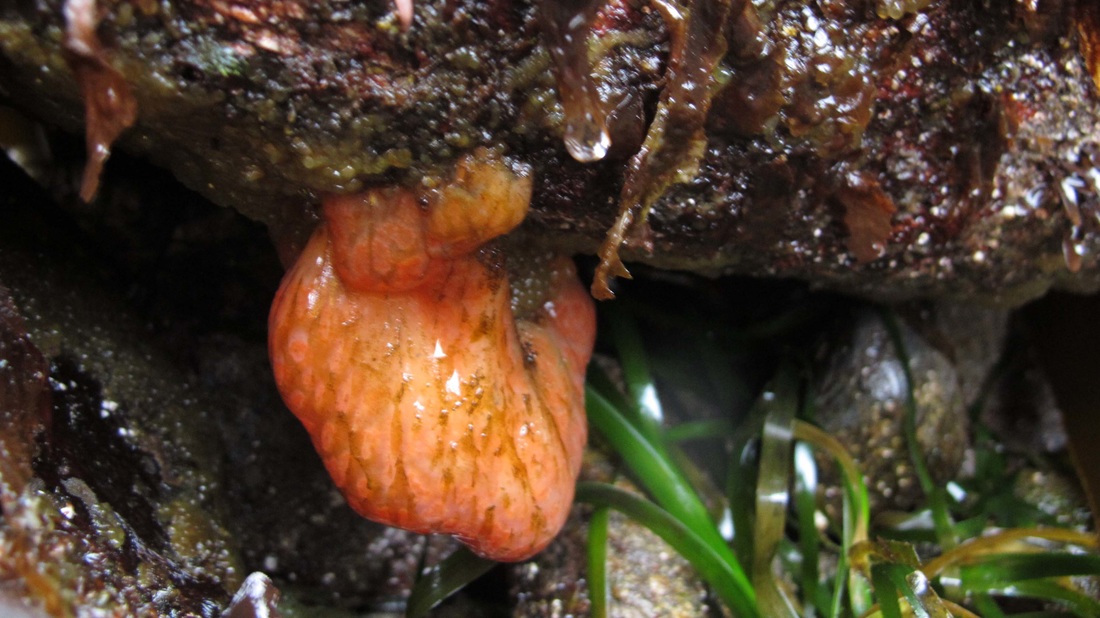Red ascidian, sea pork • Aplidium solidum
Identification
This compound ascidian forms a lumpy, slab-like colony, consisting of bright red zooids (individual members within the colony) encased in a reddish fleshy or gelatinous mass. The zooids vary in length (average 12 mm long) and are arranged in small, irregularly-shaped systems. Colonies have been measured to 20 cm across and up to 5 cm thick, though 2-3 cm is more common.
Habitat & Range
Red ascidian colonies grow on rock and pilings in areas exposed to currents. It is a relatively common species that is found in the intertidal and subtidal to 40 m deep, from British Columbia to southern California.
Similar Species
Compound tunicates can be tricky to ID: not only can they be difficult to distinguish from each other, but they can even be hard to tell apart from similarly amorphous encrusting sponges. There are a number of reddish-coloured species of both groups found in coastal BC waters. The California sea pork (Aplidium californicum) is one such ascidian: forms thinner slabs (1-2 cm thick), has smaller zooids (6 mm long), and is duller and more variable in colour. Another similar species is the red-dotted compound tunicate (Eudistoma molle), which is more opaque and whitish with red, irregularly-placed zooids.
Intriguing Info
The opalescent nudibranch (Hermisseda crassicornis) feeds on red ascidian zooids.
iNaturalist
https://www.inaturalist.org/taxa/195372-Aplidium-solidum
This compound ascidian forms a lumpy, slab-like colony, consisting of bright red zooids (individual members within the colony) encased in a reddish fleshy or gelatinous mass. The zooids vary in length (average 12 mm long) and are arranged in small, irregularly-shaped systems. Colonies have been measured to 20 cm across and up to 5 cm thick, though 2-3 cm is more common.
Habitat & Range
Red ascidian colonies grow on rock and pilings in areas exposed to currents. It is a relatively common species that is found in the intertidal and subtidal to 40 m deep, from British Columbia to southern California.
Similar Species
Compound tunicates can be tricky to ID: not only can they be difficult to distinguish from each other, but they can even be hard to tell apart from similarly amorphous encrusting sponges. There are a number of reddish-coloured species of both groups found in coastal BC waters. The California sea pork (Aplidium californicum) is one such ascidian: forms thinner slabs (1-2 cm thick), has smaller zooids (6 mm long), and is duller and more variable in colour. Another similar species is the red-dotted compound tunicate (Eudistoma molle), which is more opaque and whitish with red, irregularly-placed zooids.
Intriguing Info
The opalescent nudibranch (Hermisseda crassicornis) feeds on red ascidian zooids.
iNaturalist
https://www.inaturalist.org/taxa/195372-Aplidium-solidum
References
Cowles, D. (2008). Aplidium solidum (Ritter and Forsyth, 1917). Invertebrates of the Salish Sea. Rosario Beach Marine Laboratory. Accessed 01/12/2015.
Lamb, A., and Hanby, B. (2005). Marine Life of the Pacific Northwest [electronic version]. Madeira Park, BC: Harbour Publishing.
Watanabe, J. (2011). Phylum Chordata, Subph. Urochordata: Subtidal Tunicates. SeaNet: Common Marine Organisms of Monterey Bay, California. Stanford University, Stanford, CA. Accessed 01/12/2015.
Authors and editors of page
Kelly Fretwell (2015).
Cowles, D. (2008). Aplidium solidum (Ritter and Forsyth, 1917). Invertebrates of the Salish Sea. Rosario Beach Marine Laboratory. Accessed 01/12/2015.
Lamb, A., and Hanby, B. (2005). Marine Life of the Pacific Northwest [electronic version]. Madeira Park, BC: Harbour Publishing.
Watanabe, J. (2011). Phylum Chordata, Subph. Urochordata: Subtidal Tunicates. SeaNet: Common Marine Organisms of Monterey Bay, California. Stanford University, Stanford, CA. Accessed 01/12/2015.
Authors and editors of page
Kelly Fretwell (2015).





